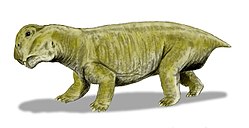| Vivaxosaurus Temporal range: Late Permian | |
|---|---|
 | |
| Life restoration of Vivaxosaurus trautscholdi | |
| Scientific classification | |
| Kingdom: | |
| Phylum: | |
| Class: | |
| Order: | |
| Suborder: | |
| Infraorder: | |
| Genus: | Vivaxosaurus Kalandadze & Kurkin, 2000 |
| Species | |
| |
| Synonyms | |
| |
Vivaxosaurus is a genus of dicynodont from the late Permian (Changhsingian) of Russia. [1] [2] It has been found at Sokolki on the Northern Dvina River near Kotlas in Arkhangelsk Oblast. Vivaxosaurus was likely a contemporary of Inostrancevia , Scutosaurus , and Dvinia . Like all members of the genus, this animal was toothless, except for prominent tusks, and probably cropped vegetation with a horny beak, like a tortoise.






